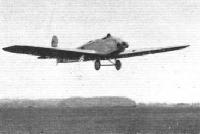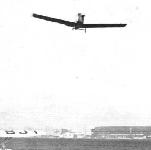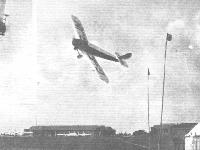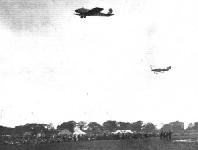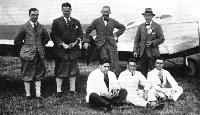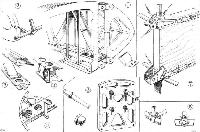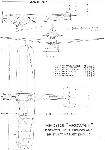
Jane's Encyclopedia of Aviation
Bristol Brownie (UK)
Two-seat light aeroplane built for Air Ministry competitions in 1924. Two Brownies competed, one with wooden and one with metal wings, the latter winning second prize of ?1,000. Power was provided by a 24 kW (32 hp) Bristol Cherub I engine.
Описание:
- Jane's Encyclopedia of Aviation
- Flight, September 1924
THE BRISTOL "BROWNIE" MONOPLANES (NOS. 1 AND 2) - Flight, September 1926
British Light ‘Plane Development & Lympne Meeting
Фотографии
-
Flight 1924-09 / Flight
Регистрационный номер: G-EBJK [13] THE BRISTOL "BROWNIE" LIGHT MONOPLANE, BRISTOL "CHERUB" ENGINE: Three-quarter front view.
-
Aeroplane Monthly 1985-07 / R.Riding - Bristol Brownie /British pre-war ultralights/ (52)
Регистрационный номер: G-EBJK [13] Another view of Brownie G-EBJK in its original form.
-
Flight 1924-09 / Flight
Регистрационный номер: G-EBJK [13] THE BRISTOL "BROWNIE," BRISTOL "CHERUB" ENGINE: Front view.
-
Flight 1940-02 / Flight
Регистрационный номер: G-EBJK [13] The Brownie, with Cherub engine, was built for the light plane trials at Lympne. 1924
-
Flight 1924-10 / Flight
Регистрационный номер: G-EBJK [13] THE LIGHT 'PLANE COMPETITION, LYMPNE: The crowd is interested in the tuning-up of some of the machines.
-
Aeroplane Monthly 1985-07 / R.Riding - Bristol Brownie /British pre-war ultralights/ (52)
Регистрационный номер: G-EBJK [13] The Light 'Plane Competition, Lympne: The Bristol "Brownie" monoplane, No. 1, gets away. It is fitted with a Bristol "Cherub" engine.
Uwins flying the unregistered and repaired G-EBJK at Lympne in September 1924. -
Flight 1927-04 / Flight
MACHINES IN USE BY THE LONDON AEROPLANE CLUB: These are four de Havilland "Moths" with "Cirrus" engines, and a Bristol "Brownie" with Bristol "Cherub" engine
Другие самолёты на фотографии: De Havilland Moth / D.H.60 - Великобритания - 1925
-
Flight 1926-09 / Flight
Регистрационный номер: G-EBJK [13] READY FOR BRIGHTON: Some of the machines lined up ready for the start on the first circuit on Sunday morning. On the right, the Bristol "Brownie," which was the first machine away. The other machines are the Parnall "Pixie," the Avro "Avis," and the de Havilland "Moth."
Другие самолёты на фотографии: Avro Avis / Type 562 - Великобритания - 1924De Havilland Moth / D.H.60 - Великобритания - 1925Parnall Pixie - Великобритания - 1923
-
Flight 1926-09 / Flight
LINE UP FOR THE S.M.M.T. RACE: From left to right the machines are: de Havilland "Moth," Avro "Avian," Farnborough "Cygnet," Parnall "Pixie," and Bristol "Brownie." This race was won by Hinkler on the Avro "Avian," at an average speed of 90 m.p.h.
Другие самолёты на фотографии: Avro Avian / Type 594/616 - Великобритания - 1926De Havilland Genet Moth - Великобритания - 1926Hawker Cygnet - Великобритания - 1924Parnall Pixie - Великобритания - 1923
-
Jane's All the World Aircraft 1980 / Encyclopedia of Aviation - Aircraft A-Z - v2
Регистрационный номер: G-EBJK [13] Bristol Brownie.
-
Flight 1925-07 / Flight
Регистрационный номер: G-EBJK [13] ONE OF THREE BRISTOL MACHINES ENTERED FOR THE LYMPNE MEETING: The Bristol "Brownie" light monoplane with Bristol "Cherub" engine.
-
Aeroplane Monthly 1985-07 / R.Riding - Bristol Brownie /British pre-war ultralights/ (52)
Регистрационный номер: G-EBJK [13] THE BRISTOL "BROWNIE" LIGHT MONOPLANE, BRISTOL "CHERUB" ENGINE: Three-quarter rear view.
G-EBJK photographed in its original form, before its crash at Filton on September 5, 1924. -
Flight 1926-09 / Flight
Регистрационный номер: G-EBJK [13] No. 3. The "Bristol Brownie," with Bristol "Cherub" Engine: Side view. Note the addition of a deck fairing on top of fuselage.
-
Aeroplane Monthly 1985-07 / R.Riding - Bristol Brownie /British pre-war ultralights/ (52)
Регистрационный номер: G-EBJK [13] The original Brownie after conversion to Type 91B. Note the revised rudder and streamlined nose. The aircraft also has a sprung undercarriage, horn balanced rudder and specially built 17ft 4 1/2 in steel wings.
-
Aeroplane Monthly 1985-07 / R.Riding - Bristol Brownie /British pre-war ultralights/ (52)
Регистрационный номер: G-EBJL Brownie G-EBJL converted to a single-seater.
-
Aeroplane Monthly 1985-07 / R.Riding - Bristol Brownie /British pre-war ultralights/ (52)
Регистрационный номер: G-EBJM [3] The third Brownie, G-EBJM, was first flown on September 24,1924, and is seen here as a single-seater.
-
Flight 1926-09 / Flight
THE START OF THE COMPETITION: Some of the competing machines on Sunday morning at the start for Brighton. 1, Uwins on the Bristol "Brownie" was the first man away.
-
Air Pictorial 1956-01 / Photos by request
Регистрационный номер: G-EBJK [13] BRISTOL TYPE 91 BROWNIE. The Brownie was one of the entries in the Air Ministry's Two-seat Light Aeroplane Competition at Lympne in 1924. The Mark I illustrated, G-EBJK, was a metal version, with a 33-h.p. Bristol Cherub engine. The two Type 91 Mark IIs, G-EBJL and JM, had metal fuselages and wooden cantilever wings. Flown by Captain Cyril Uwins, then chief test pilot to the Bristol Aeroplane Company, the Mark I gained the second prize of ?1,000 at Lympne, when its maximum speed was 65.19 m.p.h. and its lowest speed 38.73 m.p. h. It flew 512.5 miles in 10 hours 21 minutes.
The Mark I had a span of 30 ft. 7 in., the Mark 11, 36 fl. 7 in. The empty weight was 500 lb. and the loaded weight 870 lb. -
Flight 1924-10 / Flight
LOW-SPEED FLYING AT LYMPNE: 1, Uwins on the Bristol "Brownie." Sir Geoffrey Salmond in the foreground.
-
Flight 1939-03 / Flight
TAKE-OFF AND PULL-UP TESTS AT LYMPNE: 3, Uwins "hoiking" the Bristol "Brownie" over the posts in the take-off test.
The Bristol Brownie which took part in the Lympne light plane competitions. It was fitted with a Bristol Cherub flat-twin engine of 34 h.p. -
Flight 1927-10 / Flight
BRISTOL'S AIR MEETING: Capt. F. Barnwell, the famous Bristol designer, giving an exhibition on the Bristol "Brownie."
-
Flight 1924-10 / Flight
The Bristol "Brownie" monoplane, No.2, heads for the starting line at Lympne. The best get-off in 1924 was made by the Bristol "Brownie," with Bristol "Cherub" engine, piloted by Cyril Uwins.
-
Flight 1926-09 / Flight
Регистрационный номер: G-EBJM [3] THE LYMPNE OPEN HANDICAP: 2. The single-seater Bristol "Brownie" in a sharp turn.
-
Flight 1925-08 / Flight
Регистрационный номер: G-EBJM [3] LOW-WING MONOPLANE: Uwins rounding the mast on the Bristol "Brownie."
-
Flight 1927-05 / Flight
THE HAMPSHIRE AIR PAGEANT: The first two home, who were, however, disqualified - Uwins on the Bristol "Brownie" and Le Poer Trench on "Halton I"
Другие самолёты на фотографии: Halton H.A.C.1 Mayfly/H.A.C.2 Minus - Великобритания - 1927
-
Aeroplane Monthly 1985-07 / R.Riding - Bristol Brownie /British pre-war ultralights/ (52)
THE FIRST OF THE ELIMINATING TESTS AT LYMPNE: Some of the competing machines photographed during the folding, housing and re-erecting test. 5, the Bristol "Brownie."
A Brownie passes through the 10ft alley-way during the eliminations at Lympne on September 27, 1924. -
Flight 1926-09 / Flight
THE BRISTOL TEAM: From left to right, standing, P. Mayer, R. Fedden, F. Uwins, and A. Suddes. Seated, W. Allen, F. Chard, and F. Godfrey.
-
Flight 1924-10 / Flight
CONSTRUCTIONAL DETAILS OF LIGHT 'PLANES AT LYMPNE: (6) Under carriage of Bristol "Brownie"
-
Flight 1924-10 / Flight
SOME MORE CONSTRUCTIONAL DETAILS FROM LYMPNE: (6) Locking-pin arrangement on rear spar of Bristol "Brownie."
-
Flight 1924-09 / Flight
SOME BRISTOL "BROWNIE" CONSTRUCTIONAL DETAILS: Some of our sketches show features common to all three Bristol machines, but those relating to the wing structure show the all-metal construction. 1, the root of the port wing. Note the very original spar web, consisting of a circular steel tube bent zig-zag fashion and flattened out at the points of attachment to the spar flanges. 2, details of the attachment of the leading edge. 3, 4 and 5, details of the spar construction. Towards the wing tip, where the spar depth becomes smaller, the zig-zag web is not continued, and the construction is of the form shown. 6 illustrates the mounting of the "Cherub" engine on four tubular cantilever pillars without bracing. These pillars are permanently bolted to the engine, and are attached to the engine bulkhead by unions. 7 shows the attachment of the wing to the fuselage. A wood bulkhead is built-in at this point, although the fuselage is of steel tube construction, and the upper spar flange attachment has provision for setting dihedral and incidence by the micrometer adjustment shown. 8 shows a typical fuselage joint.
-
Flight 1924-10 / Flight
A FEW UNORTHODOX TAIL SKIDS ON LYMPNE MACHINES: The Bristol is a leaf-spring and the Avro a bent tube. The Short has a long straight, tubular skid, and the Westlands a horizontal Vee with compression spring to the stern-post.
Другие самолёты на фотографии: Avro Avis / Type 562 - Великобритания - 1924Short Satellite / S.4 - Великобритания - 1924Westland Wood Pigeon - Великобритания - 1924
-
Flight 1924-09 / Flight
Bristol "Brownie" 2-seater Light Monoplane Bristol "Cherub" Engine
- Фотографии
















